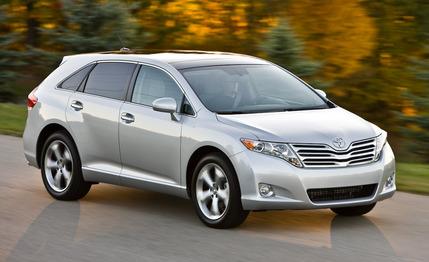
 Short Take Road Test
Short Take Road Test
During the Toyota Venza press presentation in gorgeous Farmington, Pennsylvania, we listened to Toyota describe the recipe for the perfect modern station wagon: Take one of the country’s most popular sedans—the Camry, natch—add more trunk room for your junk, raise the roof a few inches, and leave everything else where it is. The thing is, Toyota won’t call the Venza a wagon.
Nor, for that matter, does it consider the Venza a crossover, the term every other manufacturer calls its wagons when it's too chicken to call them wagons. To describe the Venza, then, Toyota came up with a yet-undiscovered wagon-avoidance term: “the car, optimized.”
Mix of Highlander and Camry
Eyes rolled around the room. Isn’t “the car, optimized” the very definition of a wagon? Toyota’s feeling is that the Venza is about 70-percent car, 30-percent SUV, but in contrast to most crossovers and sport-utes, the Venza makes no promises of off-road dexterity. (Although, interestingly, the Venza offers the same 8.1 inches of ground clearance as does Toyota’s own Highlander.) It also doesn’t offer a third-row-seat option, so mechanically speaking, what you have here essentially is “a Camry, optimized.”
But you wouldn’t know it by looking. Designed by teams based in Newport Beach, California, and Ann Arbor, Michigan, the Venza shares nary a body panel, lighting element, or major interior component with the Camry or Highlander, the vehicles with which it shares a platform. The Venza’s strong mug features cat’s-eye headlamps and a grille scaled more for a Freightliner than a family car. The profile is a bit thick in the middle, but the Venza’s arched fenders, thick D-pillars, standard 19-inch wheels (20s on the V-6), and highly detailed rear end convey presence and style. Crossover? Wagon? Whatever it is, it looks good in the metal.
Of Course, the Interior Is Clever
The Venza’s generous exterior dimensions bestow the interior with plenty of space, and even the preproduction vehicles we drove had the sort of assembly and materials quality we expect from Toyota. Unlike most Toyotas, the Venza will come in one grade with several option packages to suit buyers’ whims, some that include cool textured leather upholstery.
Ergonomically and aesthetically, the Venza interior features many nice touches such as an optimal location for the gearshifter, dressy black carpeting to offset the gray or beige upholstery, and an attractive gauge cluster. On the down side, the optional fake wood looks fake, and the dual-zone HVAC controls seem as if they were crammed into the design at the last minute. Sit-in height is the same as that of the Camry, Toyota says, and after slipping into and out of the Venza several times, we surmise that grandparents and grandchildren alike should find ingress and egress pretty easy.
Now, no crossover/wagon/car-optimized thingy could be launched without its own “gotcha” features, and the Venza has two. The sliding center-console components—cup holders, armrest, tray, etc.—make it a veritable Rubik’s Cube of cabin storage. And of the two optional 13-speaker JBL sound systems, the top-shelf version (bundled with the navigation package) is Bluetooth-equipped, allowing for music streaming from compatible devices. The dash even has a dedicated music-device cubby beneath the HVAC buttons.
In back, the huge rear seat fits three adults with little problem, with copious legroom and comfortable 60/40-split reclining seatbacks (although we couldn’t get them to fold completely flat for hauling purposes). If back-seat passengers are important to you, we recommend the two-row, two-piece sunroof, which turns the Venza’s relatively dark cabin into a much brighter place.